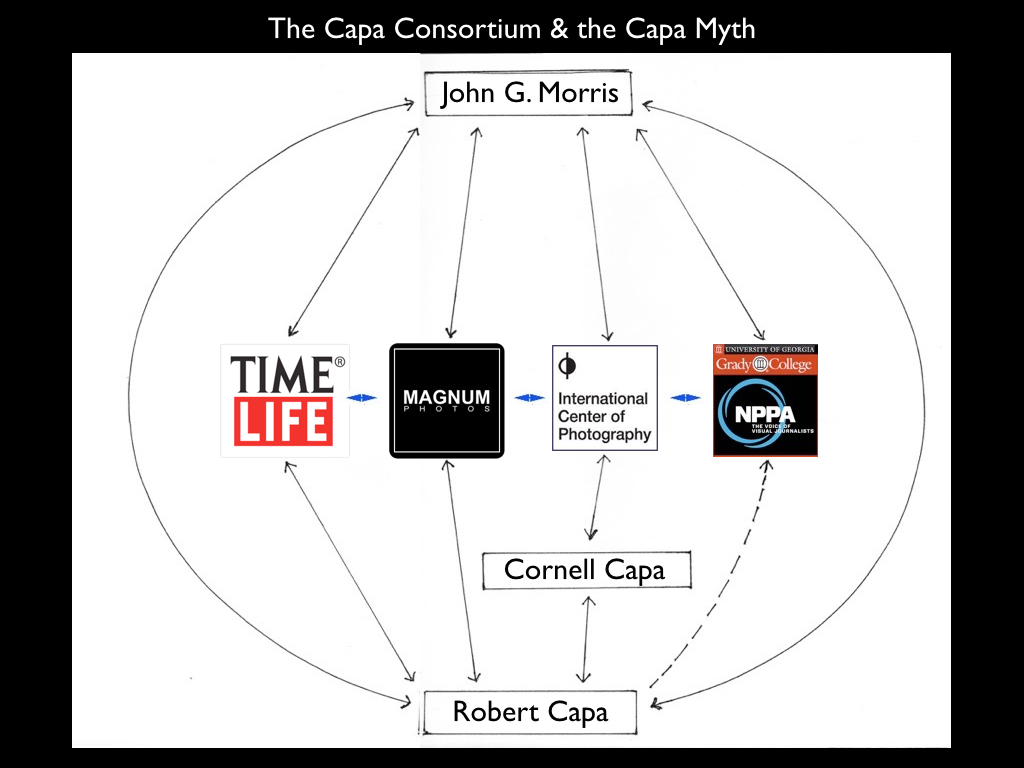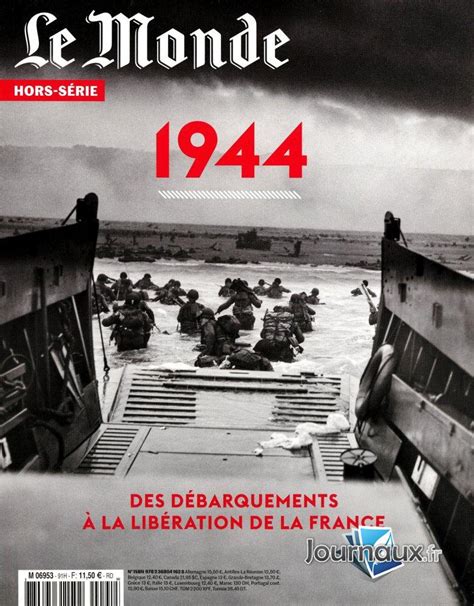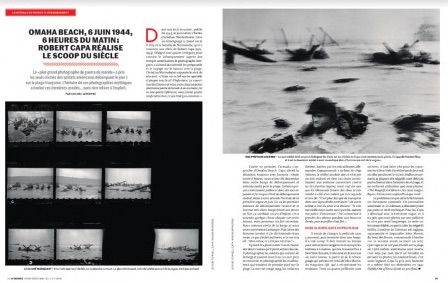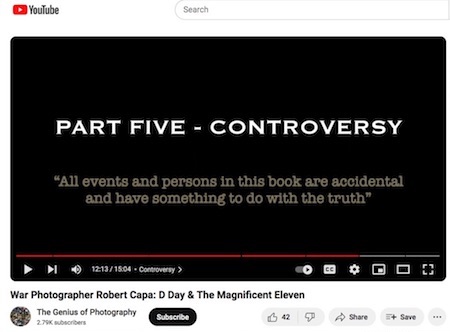 Ten Years On (more)
Ten Years On (more)
… Per my last post, in conjunction with the 80th anniversary of D-Day (and the 10th anniversary of the Capa D-Day project), several prominent U.S. websites published features that referred to our investigation and treated it respectfully, as a reliable source of information and a counterbalance to the prevailing myth.
While the Capa D-Day project has already received such acknowledgment both in the States and abroad, and has also begun to have a demonstrable impact on scholarly research in the fields of photo history, military history, and media studies, it has not until now become itself the subject of scholarly analysis. That changed with the publication of “Twenty Pounds of Headlines Stapled to His Chest: Unbranding Robert Capa,” by Robert Dannin, which appeared on May 27, 2024 at Dispatches – The VII Insider Blog.
Dispatches, which uses the Substack platform and currently claims over 3000 subscribers, describes itself thus:
Dispatches is where you will find the best writing on the role of images in our world, along with new and diverse visual stories from around the world. Dispatches is by VII Insider, a program of The VII Foundation in partnership with PhotoWings.
We focus on non-fiction photography, documentary storytelling, and visual journalism. In a world where beliefs and actions are increasingly out-of-sync with facts and realities, we believe that analyzing, debating, and promoting high-quality visual reports is an urgent task.
Dannin brings an insider’s first-hand knowledge of the operations of picture agencies and their complicated relations with publishers to bear on the skein of professional, corporate, and institutional connections that I have dubbed “the Capa Consortium.” In doing so, he highlights and questions several delimitations that I have placed on the project from the beginning (mostly to keep it within manageable bounds, given the available resources). His challenges suggest that expanding the project could reveal further linkages — an endeavor that I may leave to younger scholars.

The Capa Consortium, Keynote slide, © 2015 by A. D. Coleman
Here’s an extract:
Coleman deconstructs relentlessly. On almost every account, he finds discrepancies and traces them to John Morris, whose enigmatic responses do more to obfuscate than clarify the issues. He has mastered the blog format – unwieldy as it is for the reviewer – and converts it into an online platonic dialogue, parrying back and forth with Morris and his acolytes, inviting expert testimony, checking for errors, and excavating new sources. His digressions are carefully deployed to test the fragile bond between the photograph and its myriad interpretations, between the signifier (Capa) and signified (D-Day). …
While I disagree with aspects of Dannin’s analysis, I find his assessment fair and his provocations valuable. Most importantly, he recognizes that our investigation at its core goes beyond the parameters of military history and photojournalism and photo history to address the genesis, nurturance, and eventual viralization of a media myth, accomplished effectively in the analog photography/print era and then amplified by the advent of digital technology and the internet. Thus he positions our project squarely in the context where I believe it ultimately belongs: media studies.
 (Full disclosure: Dannin has contributed substantially to this blog on several occasions — though not to the Capa D-Day project. I consider him both a colleague and a friend. Based on both his scholarly credentials and his professional experience with Magnum — where he served as editorial director — and other photo agencies, I encouraged him to write an independent assessment of our project. However, I had no editorial say over the final content of his essay, nor any connection to the platform on which he has published it.)
(Full disclosure: Dannin has contributed substantially to this blog on several occasions — though not to the Capa D-Day project. I consider him both a colleague and a friend. Based on both his scholarly credentials and his professional experience with Magnum — where he served as editorial director — and other photo agencies, I encouraged him to write an independent assessment of our project. However, I had no editorial say over the final content of his essay, nor any connection to the platform on which he has published it.)
•
Though it doesn’t qualify as a scholarly source per se, Wikipedia gets used by millions (myself included) for often reliable synopses of myriad subjects. While anonymous and crowd-sourced, Wikipedia articles involve footnotes substantiating citations and quotations, and production thereof involve internal fact-checking and editorial review. In any event, this ever-changing compendium’s popularity means that its entries appear high on the results list of many if not most online searches.
As of June 6, 2024, relevant articles about Robert Capa and his D-Day photographs incorporate references to and links to our project. While we cannot determine who authored and/or contributed to these articles, Wikipedia helpfully offers a “revision history” for every entry. Consequently, we can pinpoint exactly when they factored our investigation into the content thereof. These articles are:
- “
 Robert Capa.” The revision history indicates that discussion of our project got added to the then-existing main biographical entry on February 19, 2019 — several months before the 75th anniversary of D-Day. The notes give my 2019 article “Alternate History: Robert Capa on D-Day,” published online in Exposure magazine (journal of the Society for Photographic Education) as the source.
Robert Capa.” The revision history indicates that discussion of our project got added to the then-existing main biographical entry on February 19, 2019 — several months before the 75th anniversary of D-Day. The notes give my 2019 article “Alternate History: Robert Capa on D-Day,” published online in Exposure magazine (journal of the Society for Photographic Education) as the source. - “The Magnificent Eleven.” This entry expands on the brief synopsis of the Capa D-Day story that appears in the bio entry. The revision history indicates that this more detailed discussion of our project got added to the then-existing entry on January 3, 2024 — several months before the 80th anniversary of D-Day. The notes again give my 2019 article in Exposure magazine as the source.
Given the traffic that Wikipedia attracts, the incorporation of our project into these two narratives — and the inclusion of a link thereto — ensure that henceforth many who seek basic information about this subject will encounter our revisions.
•
Across the Great Water

The prize for most noteworthy non-U.S. publication to endorse our project on this occasion surely goes to the French periodical Le Monde. In an “hors-série” special print edition datelined July 2024 but published in early June (in French), and in both French and English versions at this prominent newspaper’s website, they featured an article titled (in English translation) “At 6 am on June 6, 1944, Robert Capa landed on Omaha Beach and scored the scoop of the century,” by Michel Lefebvre.
Unfortunately, this sits behind a subscription paywall. I’ve found no accessible online version, syndicated or pirated, in either language. So while I feel free to synopsize and quote briefly from it, copyright law prevents me from posting it in its entirety. (You can read the opening paragraphs in English at the link above, and the same passages in French here: “Robert Capa débarque sur Omaha Beach le 6 juin 1944 à 6 heures du matin et réalise le scoop du siècle.” For reasons unclear, the French version gets datelined June 6 and the English translation June 5.)
Michel Lefebvre, its author, serves as one of two editors for Le Monde‘s special editions. He has also co-authored (with the late Bernard Lebrun) an excellent book on Capa, whose English-language edition bears the title Robert Capa: The Paris Years 1933-1954 (New York: Abrams, 2012). His article’s subhead: “The story behind Capa’s mythical photographs has evolved in recent years, without in any way diminishing the feat.”
Lefebvre devotes most of the article to a recap of the myth, but adds this passage near the end:
… The problem is that this pretty story is hotly contested. An American journalist, A. D. Coleman, has dismantled the mythical tale point by point. In his view, Capa arrived with the third wave, took just 11 photos on one roll of film and did not stay long. The rest is implausible, especially the burnt negatives. Coleman’s analysis is logical, well-argued and impossible to challenge.
Morris grudgingly started to waver on his version before his death in 2017. …
This article — and Le Monde‘s relationship to our project — has a complicated backstory, but I’ll save that for a later date. For the present, we’ll gladly settle for the unequivocal affirmation that our analysis is “logical, well-argued and impossible to challenge.”

Le Monde, July 2024, special D-Day issue, Capa spread
•
Franceinfo.fr is a public service news site bringing together content from the editorial offices of France Télévisions and Radio France. On June 1, 2024 they published “80 ans du Débarquement de Normandie: focus sur les photos mythiques de Robert Capa,” a four-minute recap of the Capa D-Day myth that includes a cameo appearance by Lefebvre and his approving mention therein of our corrective research.
•
Also from France, though much lower down on the scale, my search results included a link to “Le choix de Polka: Le débarquement du 6 juin 1944 par Robert Capa,” scripted by Dimitri Beck and published at the website of Polka magazine on June 5, 2024. This video, which clocks in at just under four minutes, includes a one-sentence reference to our research. (Polka is a prominent French quarterly photo magazine. Back in December 2016 the same author, writing for the same journal, published a puff piece on John Morris that parroted the Capa D-Day myth. So this definitely marks progress.)
•
 I’ll add an honorable mention for the unsigned but carefully crafted article “Robert Capa and Omaha Beach,” which appears at the website of the Imperial War Museums (London, UK). First published on March 5, 2022, this essay relies heavily on our research, especially the detailed analyses of Charles Herrick, though it never specifically mentions it, nor provides any link to it or other reference that could lead the reader directly to our work.
I’ll add an honorable mention for the unsigned but carefully crafted article “Robert Capa and Omaha Beach,” which appears at the website of the Imperial War Museums (London, UK). First published on March 5, 2022, this essay relies heavily on our research, especially the detailed analyses of Charles Herrick, though it never specifically mentions it, nor provides any link to it or other reference that could lead the reader directly to our work.
•
By way of contrast, my online search also brought up “War Photographer Robert Capa: D Day & The Magnificent Eleven,” which mixes repetition of the myth with some revisionism and mention of our research. Whoever produced this posted it to a YouTube channel on April 21, 2023. That channel, titled “The Genius of Photography,” describes itself as “dedicated to unraveling the stories behind some of the most iconic photographs ever taken, attempting to understand what make them great and shedding light on the talented photographers who brought these moments to life.”
Confusingly, perhaps by design, this channel at YouTube, which originates from the UK, bears the same title as a 6-part 2007 BBC series. But, unlike the BBC series, to which it seems to have no connection whatsoever, the videos at this YouTube channel provide no production credits, nor does the channel offer any information about its contributor(s). The videos there consist of slideshows of varying lengths with soundtracks, sometimes music only and sometimes — as in the case of this one on Capa’s D-Day images — with both music and voiceover narration.

The Genius of Photography, Capa D-Day video (2024), screenshot
•
This video, like others in the series, contains nothing beyond the generic. For reasons that will become clear if you sample it even briefly, I suspect that its producer(s) used artificial intelligence to generate the slideshow, the bland and clichéd script, and the monotonal voiceover itself. If not, then they simply aggregated and homogenized existing online commentaries the old-fashioned way.
Regardless of how this utterly banal summary of Capa’s life and work came into existence, I find it noteworthy that the person or persons behind it felt it necessary to incorporate our revisionism. This chapter, titled “Controversy,” begins at timestamp 12:10 and presents a one-minute “elevator speech” distillation of aspects of our research. However truncated, this indicates that, even for someone churning out such derivative clickbait pablum, our investigation has become not just difficult to ignore but, additionally, an accepted part of the Capa D-Day story.
•
Plus ça change …
Meanwhile, the myth chugs along, here in the States and abroad. In a survey of TIME/LIFE publications involving Capa’s D-Day photos that appeared at this blog in October 2015, I noted that this media conglomerate first acknowledged the myth (though only in passing) in 1978, but by 2004 had jumped fully on board, repeating it in a special D-Day book bearing the TIME imprint, commemorating the 60th anniversary. Thereafter they commissioned and issued several videos parroting the myth, on which I also reported here.

LIFE Magazine, D-DAY, 80 Years Later (2024), cover
In 2014, under the LIFE imprint, they published a companion volume to a 70th anniversary reprint of that book, and have now reprinted the companion volume twice, once in 2019 and again this year. D-DAY: 80 Years Later — Remembering the Battle That Won the War has a text by Douglas Brinkley, unchanged from the two prior editions, in which he writes,
“There is very little about D-Day that is ironical, but irony attaches to Capa’s 11 surviving images. As mentioned, his film underwent a hazard when being processed in London. Most shots were ruined and the others were what might be called damaged. And yet, the grainy, shaky quality of the final printed images seems to conjure the quaking of the earth, or at least the beach. It seems as if a bomb had just landed at Capa’s elbow: moments of truth, finding their truth inadvertently. Capa’s pictures might have been the most evocative of the D-Day landing regardless of what befell them in the lab, but as rendered they immediately became a signature of what had occurred. (Many years later, film director Steven Spielberg used the Capa photographs as inspiration for the look and feel of the opening scene of Saving Private Ryan.)” (See “The Longest Day: Moments of Truth,” p. 48.)
I’ll venture a guess that TIME/LIFE will trot out unrevised reprints of this volume as set pieces every five years from now till 2044. Perhaps we should consider TIME/LIFE’s revision of the myth it belatedly clasped to its bosom — should that ever happen — as the ultimate acknowledgment that our investigation has effectively dismantled the legend.
•
Addendum
Perhaps because, even with our revision, the Capa D-Day story has begun to wear thin, attention to the visual documentation of D-Day has begun to trickle down from Capa to the other photographers and cinematographers, civilian and military, who covered the first day of the invasion. Four examples evoked by my search:
• “Omaha Beach: le D-Day dans l’objectif des soldats américains,” by Alexandra Nawawi, Polka magazine, May 30, 2024. This well-researched illustrated essay addresses the work of some of the military photographers assigned to cover the landing: Robert F. Sargent (U.S. Coast Guard), and Herman V. Wall, Louis Weintraub, and Richard Taylor (U.S. Army, 165th Signal Photo Company). All, so far as I can tell, crossed the channel on the USS Samuel Chase, the same ship on which Capa sailed in both directions.
• “The D-Day Cameramen Who Filmed Normandy Invasion on June 6, 1944,” a half-hour documentary (in English) from Dutch researcher Joey van Meesen, brings attention to three of the four detachments of the U.S. Army’s 165th Signal Photographic Company that landed on the coast of Normandy to document the Allied Invasion of Europe. Published at YouTube on June 6, 2024.
• This unsigned article, “Forgotten D-Day cameramen out of shadows, 80 years on,” published by AFP News Agency on May 19, 2024, concentrates on the films of Signal Corps cinematographer Richard Taylor. Taylor went ashore that morning and, despite a bullet wound to his arm, continued filming. The Signal Corps extracted multiple film clips and still images from his 35mm. movie reels. The clips often appear in D-Day documentaries, starting just a few days after the event, and a number of the still pictures have become iconic in their own right and widely reproduced.
Taylor was a New York City-based studio photographer who volunteered for service in December 1942. (He died in 2002.) This article reports on a visit by Taylor’s daughters to the National Archives facility in College Park, Maryland, just outside Washington, DC, to examine the footage made by their father and stored there. (The article includes one amusing error: “His unit was meant to take images of the landings, but he was the only one to bring home video footage of American troops that day in Colleville-sur-Mer.” A notable feat indeed.)
This report indicates that French documentarian Dominique Forget has a two-part television project in the works about Taylor and others.
• And this short video, “Forgotten D-Day cameramen out of shadows, 80 years on,” published on YouTube by AFP News Agency to accompany the above story, concentrates on the films of Taylor and Jack Lieb, also held by the National Archives and referred to previously in our project.
(Part 1 I 2)
•
(For an index of links to all posts in this series, click here.)
•
This post supported in part by a donation from Carlyle T.
•
 Special offer: If you want me to either continue pursuing a particular subject or give you a break and (for one post) write on a topic — my choice — other than the current main story, make a donation of $50 via the PayPal widget below, indicating your preference in a note accompanying your donation. I’ll credit you as that new post’s sponsor, and link to a website of your choosing.
Special offer: If you want me to either continue pursuing a particular subject or give you a break and (for one post) write on a topic — my choice — other than the current main story, make a donation of $50 via the PayPal widget below, indicating your preference in a note accompanying your donation. I’ll credit you as that new post’s sponsor, and link to a website of your choosing.
And, as a bonus, I’ll send you a signed copy of my new book, poetic license / poetic justice — published under my full name, Allan Douglass Coleman, which I use for my creative writing.






Incredible reporting on the D Day myths of Capa’s
( hardly combat )11 negatives!
Brings to mind when I was still a teenager in 1960 my mom knew the Life magazine photorapher Fritz Goro who invited me up to the Life magazine studio I think on West 46th street, Goro knew I was already an accomplished darkroom printer and recommended me for a job as such in Life’s studio’s. I then was ordered to pass a physical to work in the print lab, after I showed the darkroom manager my prints and resume, I took the physical and soon Life turned down my employment ..why? The Dr,stated on his physical report about me that my hands were sweaty that was enough to cancel me out.
To this day I can only imagine that a teen’s sweaty hands upon a hand shake meant nervous behavoir.
I last saw Goro at that studio when he photographed a Life magazine cover that was to bring to the world two menlooking at a 3D model of what would be known as DNA.
For once I can add a very, very small piece of information to one of your posts, or rather to something you quoted in your post. The photograph by Capa that inspired Steven Spielberg came from the collection of my late friend John Benton-Harris, (September 28, 1939 – August 26, 2023), John was born in Brooklyn and studied with Brodovitch, but after serving in Italy as a photographer in the US army came to London, having married an English woman. He often regretted having sold the picture.
Can you elaborate a bit? If I understand you correctly, John Benton-Harris sold a print of one of Capa’s D-Day photos to Steven Spielberg. Do I have that right? If so, can you specify which image? “The Face in the Surf”?
Thanks again for your thoughtful periodic responses to this project at your own blog.
Yes, I understand John meant the Face in the Surf. He had bought a print I think in the 60s when photographs were cheap. He had a great collection of images on show in his house in Croydon which I often visited when I got to know him in the 1990s – my closest photographer friend was a former student of John when he taught at Wimbledon School of Art, I think at the time John was printing the Tony Ray-Jones pictures for ‘A Day Off. in 1974.
But John had my favourite Cartier-Bresson, several Kertesz prints, Walker Evans, Leon Levenstein, Dan Weiner and others framed on his walls as well as many others not on display. He’d known many of the New York photographers as a young man and I think exchanged pictures with them. And certainly had many stories about them which he told – I often tried to persuade him to write them down but I think he never did.
Spielberg, according to John’s account bought the print when he was researching Saving Private Ryan. I don’t know if it was a direct private sale or if it went through Christies. John would often tell me or other photographer friends he regretted having sold the print.